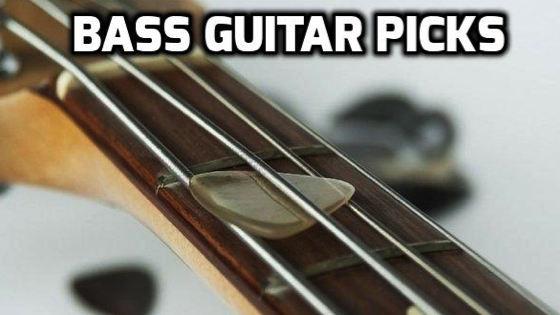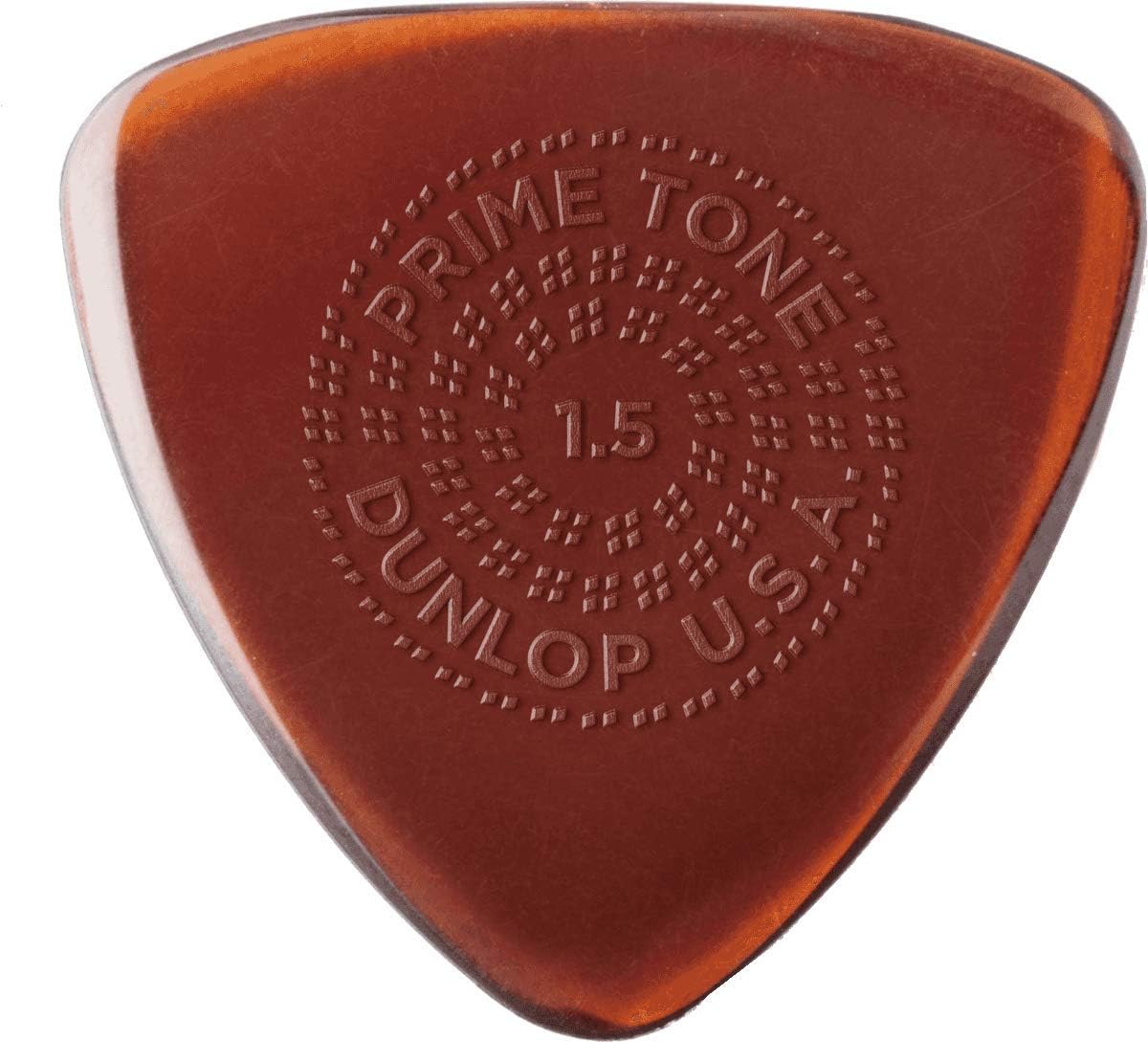Last Updated on March 30, 2024 by Justin
Welcome to the world of Bass picks! I’ll be discussing my top 16 best plectrums as well as providing a guide to help you choose the right bass pick for you.
Now you may or may not be aware but there’s been an argument among bass players for many decades. This is the debate regarding using a pick or using one’s fingers when it comes to playing the bass guitar.
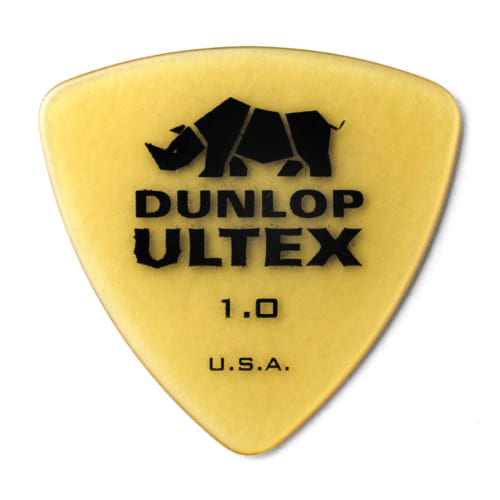 |  | 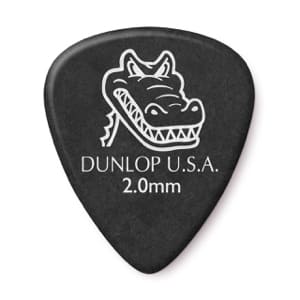 |  | 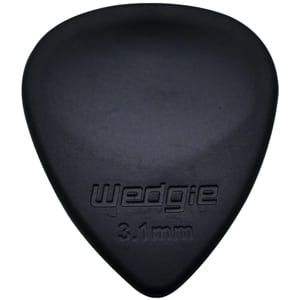 |
Many players believe that the bass guitar should not be played with a pick. While others believe in using picks. Whether you agree or disagree, the use of bass guitar picks is here to stay.
Just like with the regular guitar pick, there are a ridiculous amount of options out there. Where do you start you may ask? This guide will hopefully help you when it comes to choosing picks for bass.
Contents
- Choosing a Bass Pick: Thickness Matters
- What Material Should My Bass plectrum be?
- Bass Picks Vs Guitar Picks
- My Top 16 Bass Picks
- 1) Dunlop Ultex
- 2) Dunlop Stubby
- 3) V-PICK Dimension
- 4) Tortex Triangle Picks
- 5) Fender Celluloid
- 6) D’addario Waves Tri-Tip
- 7) Wedgie Rubber Guitar Picks
- 8) Lemmy Signature Picks
- 9) Clayton Wooden
- 10) Dragons Heart Picks
- 11) Dunlop Felt Picks
- 12) Dunlop Primetone
- 13) Gator Grip
- 14) Gravity Picks Classic Big Mini
- 15) Nylon Max Grip Bass Picks
- 16) Sharp and Point Picks
- Should a Bass Player Use a Pick?
- What Kind of Pick Should You Use for Bass?
- Why are bass picks triangular?
- Is a bass pick and a guitar pick the same?
- Best Bass Picks In Conclusion
Choosing a Bass Pick: Thickness Matters
Bassists generally use thicker picks. The reason for this is twofold. Firstly, a thicker pick improves the control you have over the strings. And secondly, the thickness has an impact on your overall tone.
Remember, bass strings are much thicker than guitar strings. Therefore, a thinner plectrum will give you much less control in comparison to a thicker plectrum. And, your tone will suffer in that it could sound “thin”.
Having said all of that, there are still many bass players out there who do prefer to use thinner picks. At the end of the day, it all comes down to the sound you want to achieve. And the way you want the bass to feel in your hands.
It may be best to write down a list of what you want to achieve in terms of sound and feel. And then, review the bass picks below. If you have absolutely no idea where to start, a gauge of 1 mm is a good place to get going.
From there you can go up or down in thickness depending on your taste. On average, bassists tend to use gauges from 1- 2 mm. When it comes to bass pick shapes, there is once again a fortune out there to choose from.
However, it seems the two most popular shapes are the Triangle (Tri-tip) and the regular shape. Most plectrum brands give you a lot of shape and gauge options.
What Material Should My Bass plectrum be?
The material you decide to go with will ultimately lend itself to the type of music you want to play. It will also determine the way your bass sounds and it will affect the way it feels in your hands. Some of the more popular materials include:
- Tortex
- Nylon Picks
- Ultex
- Wooden picks
- Acrylic
- Celluloid picks
- Metal
- Stone Picks
- Delrin Picks
However, you can get bass guitar picks in almost all different shapes and sizes as well as a multitude of brands and manufacturers to choose from.
Bass Picks Vs Guitar Picks
There is quite a lot of misinformation out there regarding bass picks. Essentially, there is no such thing as a special bass guitar plectrum. Or a special guitar plectrum. Instead, there are simply plectrums. And you can choose which one you would like to use for this application. There are literally no rules when it comes to bass picks.
Having said that, there are most certainly better-suited plectrums for the application of bass playing. Most of which will I discuss further down the page.
My Top 16 Bass Picks
If you want to make music, you NEED bass. It is as simple as that. I’ve played a lot of bass over the last decade. And, I’ve tried many guitar picks in that time. For that reason, I’d like to review my best bass picks based on my opinion. Be sure to also check out my best picks for guitar (not bass).
1) Dunlop Ultex
The Dunlop Ultex Tri-tip by Jim Dunlop is my favorite bass pick of all time. I particularly like the 1.00mm gauge thickness. But there are of course many more gauges and shapes to choose from in the Ultex range.
Two things that stand out to me the most with the Ultex are the incredible tone. As well as its durability. It also feels really good in the hands and responds really well with the bass strings. If you need a pick that allows you to cut through any mix then I most definitely recommend going for the Ultex. Gauges include 0.60, 0.73, 0.88, 1, and 1.14.
Lastly, the Ultex range offers many shapes including regular, triangle, and Jazz iii shapes. You can read more about Ultex in my review of the Ultex Jazz III.
2) Dunlop Stubby
My second favorite bass pick is yet another made by Dunlop. These picks are really popular among bassists and surprisingly popular among guitarists too.
Stubby’s only come in thicker gauges. The lightest gauge available is 1.0mm, It’s made from a material called “Lexan”. Which I think is some sort of acrylic or hard-plastic variant. As a result, the pick produces a brighter tone when compared to other picks.
The stand-out feature is the awesome molded grip. This feature is very useful for me when playing bass as there is a lot more resistance from the strings when compared to playing regular guitar. Despite its thick and large size, the stubby picks allow the bass player to play much faster whilst maintaining maximum control.
Finally, I have to mention how durable the Stubby picks are. Whilst the pick takes a massive beating from my playing style, it somehow manages to wear down a lot slower than most other picks I’ve used. Gauges of the stubby picks include 1.0mm, 2.0mm, and 3.0mm.
3) V-PICK Dimension
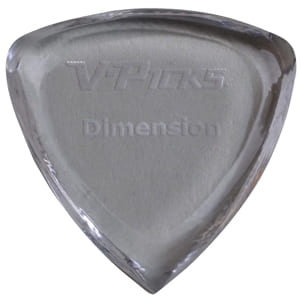
![]()
I’ll start out by saying that I love the whole V-picks range. They’re one of the best-kept secrets in the guitar and bass industry. And I say “secret” jokingly because V-picks are used by some of the most famous guitarists including Santana and ZZ-top.
My favorite of their range for playing bass is the V-picks Dimension. It comes with one sharp tip and another two rounder tips. The sharp tip is better for playing single notes and lead lines. I prefer the rounded tips for playing bass as the tone is a lot warmer which I like best for my bass sound.
The gauge is 3.0mm which is super heavy but don’t let the thickness put you off. Because, after a few minutes of playing, you’ll forget about its gauge completely. One of my favorite features is the grip this pick has.
The acrylic warms up in your fingers and sticks to them which means you can play with greater control. And a bonus feature, you’re unlikely to drop it because the pick has a fantastic grip.
4) Tortex Triangle Picks
I’d go out on a limb and say that the whole Tortex range is probably the most popular in the world. Don’t quote me on that but regardless, they’re popular for a reason. They sound great and they feel incredible in the hands.
The Green Tortex in the triangle shape is my go-to pick for when I want to play indie music. The tone this pick makes allows me to achieve the exact sound you’d expect to hear on some of the most classic indie-rock bass tracks.
When it comes to grip, they’re decent. But not quite as grippy as the first three I have listed above. Tortex picks come in so many different shapes and colors. Furthermore, each color of the Tortex plectrum range represents a different gauge.
Gauges of the Tortex bass picks range from 0.50, 0.60, 0.73, 0.88, 1.0, 1.14. Shapes of the Tortex range also include Triangle, Regular, Jazz, Jazz XL, Sharkfin, Teardrop, Flex, and Pointy. For more info on how Tortex sounds, check out my review on the difference between Tortex and Ultex.
5) Fender Celluloid

![]()
Fender celluloid is next up on my list. I included them because they have been very popular for many decades now. Players such as Jimi Hendrix have been known to use Fender celluloid.
And yes, whilst he is obviously not a bass player, my point is that Fender celluloid picks are very good and popular for a reason. As usual, I have opted for the triangle shape but it is definitely worth mentioning that they come in a wide array of shapes. For playing bass guitar, celluloid is not for everyone. But I like using them on my bass when I’m playing classic rock and music from the 60s and 70s.
6) D’addario Waves Tri-Tip
D’addario Delrin 1.14mm Triangle
This Planet Waves bass guitar pick is D’addario’s version of the Fender celluloid pick above. However, there are definitely a few differences. Firstly they are made from Delrin and not celluloid.
These Planet Waves picks allow for precise picking and have a nice wide gripping surface. The bass pick is Tri-tip meaning it has a tip on three sides. Each of these can be used to even out the wear and tear. Thus, your pick will last longer. The celluloid material produces a nice large and warm sound and if that isn’t enough, the package in which the picks come in is environmentally friendly.
These exact picks come in a Duralin material as well, like the one pictured below. Gauges of these include Light, Medium, Heavy, and Extra Heavy.
7) Wedgie Rubber Guitar Picks
Wedgie Rubber Guitar Pick 3.0mm
Wedgie pick company is best known for the innovative pick holder that they make. However, If you are looking for a bass guitar pick that sounds like you’re playing with your finger then this wedgie rubber pick is the one for you.
The fact that it is made from rubber means that the guitar pick is pretty much noiseless. As a result, you are able to achieve a sound that is rich and warm. Very similar to the tone your fingers make when playing bass.
If I need a natural-sounding tone for a bass part that needs to be played with a pick, I always turn to the rubber Wedgie plectrum. Having said all of that, the pick itself is not very versatile. It is kind of a one-trick pony. But it does that one trick exceptionally well!
8) Lemmy Signature Picks
Lemmy Signature Nylon Picks by Dunlop
Lemmy from Motorhead is a bass legend in my opinion. Channel your inner Lemmy by using his signature bass picks! They are made and produced by Jim Dunlop and come in a pack of 6.
Not only do you get 6 Lemmy signature picks but you get an epic Lemmy branded bass guitar pick holder to keep them in! These are made out of the highest quality nylon and have raised tips for better grip. Gauges include 0.73, 1.14, and 0.88. Why not get yourself the Lemmy bass plectrums because why not? What would Lemmy do?
9) Clayton Wooden

I’ve featured these exact picks as part of our Wooden picks review. However, they deserve a mention in the bass picks category too. They’re part of the Clayton exotics range and the ones I have featured here are made from wood. The wood produces a very unique tone that can only be described as earthy and warm.
This unique tone cannot be replicated by synthetic materials. For that reason, they have made my top 10 list. There is also a nice dip/ditch on the pick to form a comfortable and strong gripping surface.
10) Dragons Heart Picks
Dragon’s Heart 2.5mm Guitar Pick
I have already featured Dragon’s Heart guitar picks as part of my list of cool and odd guitar picks. They’ve come up in this list because they are just as cool for bassists as they are for guitar players. If not cooler actually!
These picks were designed to last up to 1400 hours of playing time. If you add up those hours, you’ll quickly realize the extent of how durable this pick is. Essentially that equals a total of 58 days of straight playing!
This is not your regular triangular-shaped pick. That is because each tip is a totally different shape. As a result, each side has its own unique tone as well as feel. In terms of versatility, it is quite hard to compete with this Dragonheart pick. When it comes to thickness, they are very heavy, coming in at a gauge of 2.5mm. Despite their thick gauge, I find them very easy to play. Especially for playing bass.
11) Dunlop Felt Picks
The Felt pick is the least known out of all. But, have quite a loyal niche following. These Felt picks are usually used for ukulele however when played on bass the result is a smooth and flat sound that makes absolutely no noise whatsoever.
It has been my greatest pleasure discovering using these felt bass picks. Unlike most other plastic picks which tend to be on the noisy side of things. Another great thing about these bass guitar picks is that they do not slip out of the finger and also feel soft to grip.
12) Dunlop Primetone
Here is another great pick made by Dunlop that has recently become very popular. In fact, these are some of the best bass picks around. The Primetone plectrums is a relatively new pick to the market.
And they use Dunlop’s special Ultex material. These Primetone picks come in the tri-tip version as pictured above as well as the regular shape pictured below. If you are so inclined, there are also Jazz III Primetone shapes available. These come in the following three gauges: 1.3mm, 1.4mm, and 1.5mm. However, the cool thing is that you can choose a smooth version or the version with a grip.
13) Gator Grip
The Gator grip picks are definitely some of the most underrated and often forgotten about plectrums. Especially when it comes to using them as bass picks. However, this particular gator grip has become exceptionally popular for bass guitarists due to its 2.0mm size.
The Gator grips are also known for being made to the highest standards and producing a great response and attack for the player. The matte finish on the surface also helps take this pick to the next level. There are other gauges available ranging from 0.58 up to 2.0mm.
14) Gravity Picks Classic Big Mini
Gravity Picks Classic Big Mini 1.5mm
Here is another classic pick I have thrown into the mix. It is made from the highest quality thermoplastic and will improve your sound as you begin to use it. They also last a lot longer than your regular plectrum due to the high-quality material it is made from. The grip on this pick also improves as your fingers get warmer.
They are perfect for bass playing as they come in a nice thick gauge of 1.5mm and allow you to play quicker and cut through the mix louder. The Gravity picks Classic big mini is also one of my best electric guitar picks.
15) Nylon Max Grip Bass Picks
Jim Dunlop Nylon Max-Grip 1.5mm
Despite the fact that there are very popular guitar picks, they make the list for many reasons. The first and foremost reason s the intense grip that makes these picks so famous and so popular.
As a bass guitar player, you can imagine the amount of resistance there is hitting the strings. This is due to the fact that they have much thicker strings than guitars. The grip helps minimize any resistance and your fingers will lock the pick down in place no matter how hard you strum.
These nylon picks also come in a wide range of gauges however the 1.0mm version is definitely the most popular one for bass guitar. The regular Dunlop nylon picks are also popular for bass players.
These are the same as the maxi grip one except they don’t have the course grip. having said that, the regular Nylon picks still have a pretty decent grip with studded sides and raised logo. The regular nylon bass guitar picks are pictured below.
16) Sharp and Point Picks
I never thought of using these as bass picks until a fellow bassist recommended them to me. Dunlop Sharp picks are generally popular for guitarists looking to play extremely fast. In fact, you’ll find a lot of heavy metal guys using these.
Having said that, bass guitarists quickly adopted these because they allow for precise picking on the larger bass strings. They also allow the bass player to play much faster because of the extremely pointy tip. A fantastic feature you get from these picks is that they hold their memory extremely well.
This is hard to explain but it is best to try them out and see for yourself. As per usual with the Tortex range, these are available in all of their gauges as pictured below. The black and the white sharp picks are the best suited for bass guitars as they are the thickest at 1.35 and 1.5 respectively.
Should a Bass Player Use a Pick?
Choosing between a pick and fingerstyle for bass comes down to your musical goals and playing context. A pick amplifies attack and tone, offering consistency and potentially faster play, beneficial in genres like rock, punk, and metal where distinct articulation is key. However, fingerstyle allows for a broader tonal range and dynamic expression, preferable in genres requiring nuanced play, such as jazz and blues. Transitioning to a pick might necessitate an adjustment period for those accustomed to finger playing. Ultimately, the best choice aligns with the sound you aim to produce and your comfort with the instrument, making your decision a reflection of personal preference and the specific demands of the music you wish to create.

What Kind of Pick Should You Use for Bass?
Selecting the right pick for bass guitar hinges on thickness, material, and shape, each influencing your sound and comfort. For a balanced blend of control and flexibility, medium picks (0.60mm – 0.80mm) are ideal, while thick picks (0.80mm – 1.5mm and up) offer durability and a pronounced attack preferred in many styles. Material-wise, options like nylon or Delrin are sought after for their grip and warm tone. The shape, though often a standard choice, can vary with preference for a more ergonomic hold and smoother playing experience. Exploring these aspects will help you pinpoint the pick that not only complements your playing style but also enhances your musical expression, encouraging experimentation to discover the perfect match for your bass playing needs.
Why are bass picks triangular?
Bass picks are often triangular, or larger and more rounded compared to standard guitar picks, for several reasons related to playability, comfort, and sound production:

- Durability: Bass strings are thicker and create more tension than guitar strings. A triangular pick, with its broader surface area, tends to be more durable and resistant to wear when playing these thicker strings. This is especially important for styles of music that require aggressive picking.
- Comfort and Grip: The larger size and shape of triangular picks provide a better grip, which can be crucial during long playing sessions or fast passages. The added surface area allows for a more relaxed hand position, reducing fatigue.
- Tonal Versatility: The different edges of a triangular pick can offer varied tonal qualities. Players can choose between the sharper point for a more defined attack and the rounded edges for a smoother sound. This versatility is beneficial in studio settings or live performances where a range of tones might be needed.
- Sound Production: The thicker and larger surface area of triangular picks can produce a stronger, more pronounced attack, which is often desired in genres where the bass needs to cut through the mix, such as rock, metal, and punk.
- Adaptability: The triangular shape provides multiple picking surfaces. As one edge wears down, the player can rotate the pick to use another edge, extending the life of the pick and maintaining consistent sound quality.
It’s worth noting that not all bass players prefer triangular guitar picks, and the choice of pick shape is largely a matter of personal preference and playing style. Some bassists opt for standard-shaped picks for their familiarity and feel, while others might choose even more specialized shapes for their specific ergonomic or tonal benefits. Experimenting with different types of picks is key to finding what works best for your playing style and the sound you aim to achieve.
The debate over whether it’s better to play bass with fingers or a pick has been ongoing among bass players for as long as the electric bass has existed. The truth is, there isn’t a one-size-fits-all answer; it largely depends on the music style, the desired sound, and personal preference. Let’s break down the benefits of each approach to give a clearer perspective.
Is a bass pick and a guitar pick the same?
Bass picks and guitar picks can look quite similar and are sometimes interchangeable, but some specific characteristics and preferences differentiate picks designed for bass from those intended for guitar use. Here’s a detailed look at the distinctions:
Material and Thickness
- Bass Picks: Tend to be thicker to withstand the tension of thicker bass strings and provide a stronger attack. They are often made from materials that offer durability and a comfortable grip, considering the more significant force needed to pluck bass strings.
- Guitar Picks: Can range from very thin to thick, with thinner picks often used for strumming on acoustic guitars and thicker picks for lead playing on electric guitars. The material choice can vary widely, affecting the tone and playability.
Size and Shape
- Bass Picks: Are sometimes larger and might have a wider or more rounded shape compared to standard guitar picks. This design helps in handling the larger string gauges of a bass guitar, offering a better grip and control for the player.
- Guitar Picks: Come in a variety of shapes, but the most common is the teardrop shape. Some guitarists prefer smaller, sharper picks for precise lead work, while others might use larger picks for rhythm playing.
Playing Style and Tone
- The choice between bass and guitar picks can also depend on the desired tone and playing style:
- Bass Players: Might opt for thicker picks to achieve a more pronounced attack and volume, which is especially useful in genres like rock and metal where the bass needs to cut through the mix.
- Guitar Players: May choose their picks based on the nuances of the sound they’re aiming for, with the thickness and material of the pick affecting the brightness, warmth, and precision of the notes.
Interchangeability
While bass picks and guitar picks are designed with their respective instruments in mind, many players use them interchangeably based on personal preference and the specific sound they’re trying to achieve. Some bassists prefer the feel and sound of guitar picks, especially in genres requiring a lighter touch or more subtle nuances. Conversely, some guitarists might choose bass picks for their durability and the unique tonal characteristics they can bring to guitar playing, especially for heavy-picking techniques.
Best Bass Picks In Conclusion
At the end of the day, the choice is yours when it comes to bass picks. The bass guitar picks above are some of the most popular ones used by bassists in the world however you can use whatever feels the most comfortable for you.
One important thing to take into account is that guitar picks are bass guitar picks and bass guitar picks are guitar picks. What does this mean?
This means that each plectrum has been designed for something unique and specific and when it comes down to it, they are all meant to be used on stringed instruments. So with that being said, it really does not matter what type of pick you go for as long as you practice your instrument and stick to the important stuff.

Hey, fellow guitar mate! I’m Justin, I have been a professional guitarist since 2012. I have traveled the world playing on different stages alongside some of the best indie bands, at some of the biggest music festivals in the world. As a result, I’ve played lots of different guitar gear. Instead of keeping that knowledge to myself, I have set up this site to share my honest reviews of various guitar gear. But most notably, my love for guitar picks.
